|
There are many excellent web sites that detail the product history of the Corvair. I decided that there was no value in trying to duplicate this information especially since my knowledge of the Corvair engineering pales in comparison to many others. Instead, I took a more personal approach. Because the Corvair and I were inseparable during the sixties, I decided to relate my experiences with this wonderful car. The story covers ten years so it requires a patient read. I have included scans of old Corvair brochures and the few photographs I could find.
All of us who love Corvairs have tales to tell. Here are mine.
My dad was a Ford man. My mom was a Ford woman. Mom bought the first Ford V8 coupe in Sterling, Illinois. Neighbors said, “Marie doesn't drive fast, she flies low.” Dad followed a safe and sane approach to automobiles. Mom was the driver in the family. She taught us three boys in our family to drive plus a few of my high school chums plus a waitress at Kraft’s Drug Store in Lake Forest, Illinois who had repeatedly failed her driving test. I remember her setting up kitchen stools in front of our house for parallel parking practice. Dad must have picked our automobiles because we owned a string of Ford Station wagons ranging from the “woody” Country Squires to a boring white 1955 model. In 1956, mom had an input because our new station wagon featured a Thunderbird V8 and dual exhausts. In 1959, fuel economy was the big thing, miles-per-gallon had usurped 0 to 60 times, and the car world buzz was focused on the new American compacts. Naturally, we were going to get a Ford Falcon.
We felt on top of the world when we pulled in to our Lake Bluff, Illinois home in a bright red 1960 Falcon. It was equipped with the standard 80 horsepower six and a two speed automatic transmission. On our first outing to show off this feat of Ford engineering, dad decided to display the Falcon to his favorite mechanic, Mr. Roberts, who owned the Village Garage in Lake Forest, Illinois. Mr. Roberts was a one-man operation. He worked on any car from the Mercedes Benzes that were popular in Lake Forest to our Fords. We proudly drove in to his shop on North Western Avenue. Mr. Roberts emerged from the garage and walked around the Falcon with my dad. His first comment was deflating. He said, “This is nice, but have you seen the new Corvair.” He then went on to describe its unique engineering with obvious delight. Dad drove home slightly dejected. I supported him with a defense of his Falcon. However, Mr. Roberts had planted the Corvair seed in my 16 year-old brain. I was still a Ford man on the surface, but inside I was looking around.
In the spring of 1961, to my parent's surprise and delight, I was accepted into college and was on my way to a June high school graduation. I had a choice of nearby Northwestern University or joining my older brother, John, who was an Aerospace engineering student at the University of Oklahoma. I picked joining my brother. My parents then offered to buy us a car to take to school with us in the fall. During spring break, dad took us to Chicago where we looked at used Ford convertibles. I had been reading car magazines and had been transformed from a big V8 fan to a sports car nut. I knew a Corvette was out of our price range and wouldn't fit dad’s safe and sane criteria. However, there was talk of this Corvair Monza with a 4-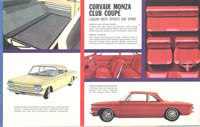 speed, a 98 horsepower engine with a Duntov cam, bucket seats, and a fabulous engine growl. I introduced the Corvair idea to mom and dad as something that wouldn't cost more than the used Ford convertible, was economical, and had Mr. Robert’s blessing. Dad wasn't sure about the four speed and bucket seats but mom carried the day for me. We ordered a 1961 Monza from McCallum Chevrolet in Lake Forest. This car would change my life. speed, a 98 horsepower engine with a Duntov cam, bucket seats, and a fabulous engine growl. I introduced the Corvair idea to mom and dad as something that wouldn't cost more than the used Ford convertible, was economical, and had Mr. Robert’s blessing. Dad wasn't sure about the four speed and bucket seats but mom carried the day for me. We ordered a 1961 Monza from McCallum Chevrolet in Lake Forest. This car would change my life.
We picked up the Monza at McCallum Chevrolet in mid-May 1961. It was a white 2-door coupe with red interior. Importantly, it had the 4-speed and the 98 horsepower Super Turbo Air engine. Since our family had automatics, mom had previously asked if I could drive this manual transmission. I answered that I was an experienced manual transmission driver from my summer job work. The truth was that I had about one minute behind the wheel of a three-speed truck. I got in as a driver, mom got in the back, and dad got in the passenger seat. With the salesman waving, I fired up the engine, lurched twice, and then shot out the front of the building where I had to make a dramatic right turn onto Deerpath Avenue. I obviously needed some work with the pedals. Dad was horrified, mom was amused, and the Monza was on its way to a short hard life as my first car.
The new Monza was quite special. It was fun to drive, looked great, and sounded awesome as I made loops around Lake Forest’s Market Square in first gear. I was convinced that I had a real American sports car. I started reading books on high speed driving and soon knew the theory behind oversteer and understeer. Our first major outing in the Monza was in June when I drove it to watch the June Sprints at Elkhart Lake, Wisconsin with my two brothers, John and Mark. We fell in with two sports cars, a TR-3 and an Alfa Romeo and enjoyed a brisk drive through the rolling Wisconsin hills. My brothers were convinced that we had a great car and that I was a second Stirling Moss. I learned a year later that I wasn't any Stirling Moss.
John and I drove the Monza to Norman, Oklahoma in the fall of 1961. Having this neat car made us popular in the dorm and fellow students frequently asked to borrow it for a date. We did loan it out from time-to-time and everyone who tried it loved it. Fall turned to winter, and in December 1961, the Monza had some rough times.
We had one of those dangerous ice & snow storms in Norman on a Sunday in early December. I was driving my brother and a friend to downtown Norman for Sunday dinner on the white slick roads. I was convinced that the Corvair was a real snow bunny and was enjoying cruising along as traditional cars spun their wheels. My enjoyment didn't last long. I approached a stop light that was blinking yellow in my direction and blinking red for the crossing traffic. A nice blue Pontiac convertible slid through the red light with all four wheels locked right in front of me. I t-boned the Pontiac at its front wheel position. No one was hurt. The Corvair was bruised but drivable. The Pontiac had to be towed off. We still had dinner as planned. The local Chevrolet dealer did a great job in repairing the Corvair so it was ready to drive home to Illinois for Christmas break. Dad had cautioned us to be careful on this 900 mile journey. Dad was going to be disappointed.
John and I left Norman with the same friend, Bill, who had been the passenger in my ice accident. We decided to leave after our last classes and drive all night so that we would arrive about noon in Lake Bluff, Illinois. We left about 10:00 pm. I drove the first leg through most of the night until we reached Springfield, Missouri. John took over driving with Bill in the front passenger seat. I crawled in the back to sleep with a pillow. I was soon sound asleep as our Corvair headed through the dark Ozarks. I was startled by a dramatic thump in the back followed by a less dramatic bump. I crawled up from my rear seat bed noticing that the car was in a slanted position. The interior was dark. The headlights pierced up and out into the dark casting a surreal light into the black sky. John then spoke the first words, “I wrecked the car.”
We took stock of our health and were relieved to see that we all seemed to be OK. In a second surreal setting, we noticed flashlights shining down on us. Soon, people were looking in the Corvair windows. I think our movement surprised them because they jumped back from peering into the car. We got out of the car through the left door since the right door was pinned. This was the first time that I noticed that the Corvair was sitting at the bottom of a deep cut with the highway high above us on our left and a rocky vertical hill face on our right. I peered through the dawn’s early light to see that the rear of the Corvair was creamed.
Soon a Missouri Trooper arrived. Bill complained of being dizzy with a sore neck so he was carted off to Rolla, Missouri in an ambulance. John and I stayed with the trooper to watch our poor Monza being hoisted from the ditch by a tow truck. Like Bill, the Monza was towed off to Rolla. The trooper then gave John and me a very high speed ride back to Rolla.
It was 7:00 am in Rolla and the Chevrolet dealer wasn't open yet. John and I stood with our poor Monza and talked about how we had arrived in this sorry state. If Ralph Nader happens to read this, he is probably saying, “See I told you so – another Corvair one car accident.” Of course, that is how we went down in the Missouri accident records. Sorry Ralph, John simply fell asleep at the wheel.
The Rolla Chevrolet people were nice. We asked them if they could fix the car so that we could get back on the road. They pointed out that the back of the car was a mess, the trunk lid was crumpled beyond repair, and that the whole engine/transmission/differential “Unipack” was out of line. The good news was that when the mechanic turned the ignition key, the engine fired right up and he was able to engage first gear and drive it for a few feet. The shop manager said that they would give it a go and that we should check back at noon.
We called dad to inform him of our predicament. He was so relieved to hear we were ok that he barely asked about the car (we had a good report on Bill from the hospital). At noon, we checked with the Chevrolet dealer to hear the good news that they thought the Corvair would be ready for the road at 4:00 pm. It was.
Today, I don’t think a car dealer would even attempt what the Rolla dealership did for us. Their approach had one focus: get the car so it could be driven. They removed the crumpled hood, bent out the flank metal, and used a large jack to get the engine et al almost lined up right. The crowning touch was a large single red light screwed to the back so it sat up high where the hood once was. The light was wired to our tail light circuit as a replacement since these tail lights were crushed into the crumpled sheet metal. We thanked the Rolla Chevrolet people and drove off happy but highly anxious to pick up Bill and hit the road. Our anxiety was fueled by the uncertainty of the car’s drivability and the weather forecast for snow on our route.
The car ran flawlessly and we beat the snow. We pulled in to our home about 11:00 pm some 23 hours after leaving Norman, Oklahoma. We drove the Corvair to McCallum Chevrolet the next day. It was quite an attraction. Everyone was amazed that some Ozark mechanics had got this wreck running. In retrospect, I think it took country mechanics to even try.
John and I took the train back to school in January. John had to leave school in March due to discovery of a tumor during an Air Force ROTC physical. He drove the repaired Monza while I finished the school year.
In March 1962, we heard about the Corvair Spyder. I immediately got a 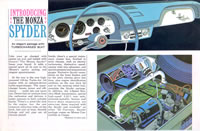 brochure and pinned the picture of the brushed aluminum dashboard on my dorm wall. I thought it was the neatest dashboard I had ever seen. I still do. You have to understand this in the prospective of what you got in 1962 in an American car. The large tachometer, classic round gauges, and aluminum faceplate were simple, functional, and beautiful. My brothers and I decided we had to get a Spyder. brochure and pinned the picture of the brushed aluminum dashboard on my dorm wall. I thought it was the neatest dashboard I had ever seen. I still do. You have to understand this in the prospective of what you got in 1962 in an American car. The large tachometer, classic round gauges, and aluminum faceplate were simple, functional, and beautiful. My brothers and I decided we had to get a Spyder.
I really didn't expect my parents to go for this Spyder idea after our disastrous record with the 1961 Monza. However, they agreed with the stipulation that we brothers had to pay for the Spyder option. Years later, I realized that their support for the Spyder was due to their knowledge of John’s cancer prognosis.
I took a job working as a bus boy in the dorm cafeteria seven days a week. Dad put down a deposit on a new Spyder at McCallum Chevrolet. As summer approached, we were acquiring the money, but McCallum was having a hard time getting a Spyder. This delay gave the 1961 Monza time to add three additional chapters to its story. Two of the stories were like the first ones and ended with broken stuff, the third was about falling in love. Love comes first.
I grew up on Scranton Avenue in Lake Bluff, Illinois. Our house was the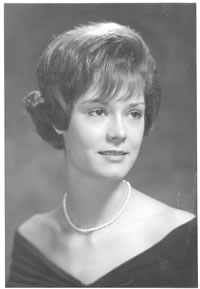 second house from the lake. The third house down from ours was owned by the Thompson family. I knew the three Thompson brothers well. They were at our house frequently because my mother gave us quite a bit of freedom and we were always launching rockets and having fun. At the start of the summer of 1962, I pulled in to the Thompson driveway to let off the older brothers. I was getting ready to pull out when sixteen year old Candace Thompson walked out of their front door, looked into the Corvair and asked if it was a stick shift. I said yes to her question and yes to her follow-up question about teaching her to drive a stick shift. I had always thought Candace was beautiful from afar. We went to different schools and really hadn't even talked before. I will spare you the details of how thrilled I was about my good luck to have a 4-speed. second house from the lake. The third house down from ours was owned by the Thompson family. I knew the three Thompson brothers well. They were at our house frequently because my mother gave us quite a bit of freedom and we were always launching rockets and having fun. At the start of the summer of 1962, I pulled in to the Thompson driveway to let off the older brothers. I was getting ready to pull out when sixteen year old Candace Thompson walked out of their front door, looked into the Corvair and asked if it was a stick shift. I said yes to her question and yes to her follow-up question about teaching her to drive a stick shift. I had always thought Candace was beautiful from afar. We went to different schools and really hadn't even talked before. I will spare you the details of how thrilled I was about my good luck to have a 4-speed.
The summer of 1962 was the great summer of my youth. I had a factory job at Hoerner box during the days but had evenings and weekends free. I spent my time with Candace and a good friend named Charles. Charlie had an old jeep. I had the Corvair. Candace was our non-girl-friend friend who went everywhere with us. I started by teaching Candace how to drive the 4-speed. She was a quick learner. Charlie and I decided it was time to teach her the guy-tricks of driving. The 1961 Monza was soon back in the repair shop.
We decided that Candace needed to learn how to burn rubber. I told her to rev the engine and then drop the clutch. She did. The Corvair leapt forward a few feet and then wouldn't go any further. The McCallum repair people, who already knew us fairly well, were not surprised to see the Monza arrive behind the tow truck. The problem turned out to be broken spider gears. I got all the teeth back and was thinking about drilling them out and giving them to Candace as a necklace but thought that this might have a downside. Candace wasn't anybody’s girlfriend yet and I didn't want to take any risks. Dad took all this very well. I didn't provide any specifics about how it happened. He assumed the spider gear problem was a leftover from the wreck in the Ozarks. It might have been; it might not have been. I was to use this assumption one more time.
In mid-July of 1962, I was heading along a nice twisty road with Charlie in the recently repaired 1961 Monza. We noticed a friend heading the other way in a classic MG-TD. We immediately decided to turn around and catch up with him. I had the Monza rapidly gaining on the MG. We were about 100 yards behind when the MG took a left turn off the main road. I kept the Monza in third gear and swung aggressively into the left turn.
As soon as I turned-in, I knew that something was different. There were two pressing problems: I was going way too fast and I had no idea what to do. My natural reaction to the first problem was to immediately take my foot off the throttle. This made things seriously worse.
The Monza’s tail swung out heading towards a spin. I knew enough to counter-steer to catch the spin but the Monza then proceeded towards the inside of the turn that had a small curb. I swerved to the right and had the Monza now driving with two wheels on the grass parkway and two wheels in the street. It was about this time that we noticed a wheel pass us on our right and then proceed smartly after the MG. Looking ahead, I noticed that our route now led directly into a telephone pole. I tried the brakes and found they had left with the wheel. Luckily, all of the friction had slowed us down enough so I was able to swerve to the right just in front of the pole. The Monza came to rest, tilted and sideways in the street. As I write this at the age of 62, I can’t imagine why our reaction was what it was. Instead of being scared, we were thrilled by the escapade. We were trying to figure out what caused the right rear wheel to snap off when, as luck would have it, a Lake Forest police car drove up.
At first the officer was occupied looking at my handiwork. Then, he looked back up the road, scowled, and started pacing off skid marks. He expressed dismay at how fast we had been going. I countered with the theory that we had just been motoring safely when, for no apparent reason, the wheel had fallen off. I suggested that the axle had caused the marks and that the distance was due to not having any brakes. I then added the Ozark accident story as the probable cause of the “weakened” axle. The officer appeared skeptical at first but he bought the theory. However, he then wrote me up for damaging village property because the Monza had dug a nice furrow down the grass parkway.
The McCallum Chevrolet tow truck soon showed up and the Monza was off again for repairs. When dad got home from work, Charlie and I explained our inexplicable accident having had a rehearsal with the police officer.
I had to go to court for damaging Lake Forest property. The judge had to look up the ticket code and found that the officer had used a code for vandalism to city property, which carried a big fine. I politely objected saying that the whole affair was due to a wheel falling off and was not deliberate. I actually think that I believed the story. The judge seemed to agree with this line of reasoning but felt that some punishment needed to be meted out. I suggested that I be ordered to plant grass to repair the damage. The judge thought that this was a splendid fitting of punishment to the crime so that is how it went down.
Dad was convinced that the 61 Monza was not to be mechanically trusted. We had to get rid of it. Because McCallum still had no idea when the Spyder would arrive, we immediately started searching the Chicago Chevrolet dealers. Our first call was to Nickey Chevrolet. We were elated to hear that Nickey had just driven a loaded 1962 Spyder onto their showroom floor.
John, Charlie, and I headed to Chicago the next day. We walked into the showroom and there it was, a white 1962 Spyder with a red interior. I have never been so thrilled by my first look at another car. We checked the window sticker and read off the performance options:
- RPO 651 Four-speed transmission
- RPO 696 Heavy-duty suspension
- RPO 480 Positraction
- RPO 686 Metallic Brakes
- RPO 693 Rear axle, 3.55:1
- RPO 690 Spyder Turbocharged engine
We called my dad and got the go-ahead on the car. The salesman said that they would need a deposit to hold the car. John and I had only pocket change. I was worried that our Spyder would be sold out from under us. Charlie saved the day. He announced that his father had him carry a signed check with a blank date and amount in case of an emergency. He then added that this sure looked like an emergency. The deal was sealed and we were told to pick up the car tomorrow when my dad would cover the purchase and get Charlie’s check back.
We drove the 61 Monza into Chicago the next day. We were so excited about the Spyder that I don’t think we even said goodbye to the Monza as it was traded-in. Soon, I was driving the new Spyder home. In this first 40 mile trip, I knew that I was driving something special.
Corvair fans know that the 1964 Corvair had the best early model suspension and that the best handling Corvair came with the 1965 rear suspension design. However, the 1962 Spyder with RPO 696 was an excellent handling car. It really was a “poor man’s Porsche.” It was highly agile, accelerated quickly, had an honest 110 MPH top speed, and, most importantly, was a tiger in the turns. I used this car to experiment with performance driving techniques and it never let me down.
The rest of the summer of ‘62 was spent with Charlie, Candace, and me 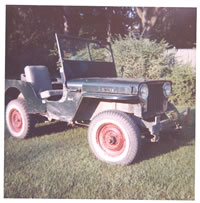 having fun. We raced Charlie’s go-kart, rode open-air in Charlie’s jeep, had slow speed time trials using Candace’s Cushman scooter, and enjoyed the Corvair Spyder. As summer headed into late August, Candace started to be more of a girl friend than a buddy and we had our first real date. Just after Labor Day, I said goodbye to Candace. The next day, John and I headed to Oklahoma in the Spyder for my sophomore year. having fun. We raced Charlie’s go-kart, rode open-air in Charlie’s jeep, had slow speed time trials using Candace’s Cushman scooter, and enjoyed the Corvair Spyder. As summer headed into late August, Candace started to be more of a girl friend than a buddy and we had our first real date. Just after Labor Day, I said goodbye to Candace. The next day, John and I headed to Oklahoma in the Spyder for my sophomore year.
In Oklahoma, we had quick steering arms added to the Spyder to correct its only deficiency. I was ready to try out the Spyder’s handling. The previous year, the SCCA held races at a Navy base south of the OU campus. There was a back section of of the course that was quite empty of traffic after hours. I picked a set of two linked right-angle corners that formed as “S” turn because the road was wide enough to get a nice arc through both turns. I drove this “S” over and over again trying out different techniques. I learned about weight transfer and using the throttle to change the angle of the car in a turn. I also learned all about Trailing Throttle Oversteer (TTO) and finally understood what mistakes I had made in my 1961 Monza’s wheel-off adventure.
The Spyder had a more successful trip through the Ozarks when we drove home for Christmas break in December 1962. The excellent traction of the rear-engine layout combined with the positraction came in handy when we encountered severe ice at dawn in the mountains. We witnessed a massive pile-up on a long bridge as trucks and cars pirouetted in what looked like slow motion along the bridge. This occurred in the opposite traffic lanes. We slowed way down. The road was completely covered with ice. We put the right wheels off the pavement onto a rough shoulder and motored along up the grade without problem.
During Christmas break, I took advantage of the snow-packed streets and parking lots to experiment with skid control. The Spyder was a regular snow bunny. I soon was able to keep it in a long slide using power and counter steering. I learned most of what I know about car control that winter in the Spyder.
At the end of the Christmas break, John’s doctors decided he should stay home to resume treatments for his cancer. The Spyder stayed with John and I took the train back to school. I walked for the remainder of my college days. My brother lost his fight with cancer.
I drove the Spyder during the summers of 1963 & 1964 when I was home from college. My Hoerner box factory job was now during swing shift. Because Candace worked during the day at Chevron in Chicago, we only saw each other on the weekends. Each night, when I drove by her dark house returning from work about midnight , I double-clutched the Spyder into first gear. Candace always listened for the engine growl before she went to sleep. Absence does make the heart grow fonder because we became engaged in 1964.
In 1964, I also had my first Mustang encounter. A Lake Bluff neighbor lady, Mrs. Kennedy, wanted a new Ford Mustang and needed help getting it home. I accompanied her to Chicago where she bought a bright red Mustang convertible with a 3-speed manual transmission. I drove the car back for her. I thought it was pretty but little else. It reminded me of my parent's Falcon, which it was beneath the sheet metal. I couldn't imagine how anybody could want one of these things over a Corvair. Boy was I wrong.
My younger brother, Mark, drove the 1962 Corvair Spyder all through his high school years and into his freshman year at the University of Oklahoma in 1965. In 1966, the clutch was gone again. Mark moved it into our single car garage and started repairs that were never finished. My mother gave the Spyder to my brother-in-law, Tom, to free the garage for her Falcon in the winter. Tom towed the Spyder to Tennessee where it disappeared from our collective memories. This 1962 Spyder was one of my all time favorite cars. It kept me wanting another Spyder when I could buy one. This opportunity came in the summer of 1965.
I graduated in the summer of 1965 with a degree in math from the University of Oklahoma. My fiancee, Candace, pinned my second lieutenant’s bars on my Air Force uniform at graduation. I was scheduled to start active duty in September. Our wedding was also planned for September in Tennessee where she now lived. I got a summer job cleaning buses for the Chicago Transit Authority at night. I had enough take-home pay to afford a new Corvair. I was thrilled with the great press on the 1965 Corvair and wanted a Turbo Corsa.
I called all of the major Chicago Chevrolet dealer’s hoping to find a Turbo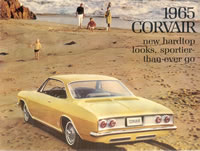 Corsa equipped with heavy duty suspension and positraction. There weren't any. Of the few Corvair Turbo Corsas in the showrooms, all had standard suspensions and no positraction. I decided to go for a Crocus Yellow Corsa coupe with a black interior. This was just like the one pictured on the cover of the 1965 Corvair sales pamphlet. After obtaining financing through my dad’s credit union, I was soon the owner of this new car. Corsa equipped with heavy duty suspension and positraction. There weren't any. Of the few Corvair Turbo Corsas in the showrooms, all had standard suspensions and no positraction. I decided to go for a Crocus Yellow Corsa coupe with a black interior. This was just like the one pictured on the cover of the 1965 Corvair sales pamphlet. After obtaining financing through my dad’s credit union, I was soon the owner of this new car.
I was somewhat disappointed when I drove the yellow Corvair Turbo Corsa home from Chicago. The Corsa felt almost too soft and comfortable compared to the hard, agile Spyder. However, I was in love with the looks. With the windows down, the sleek open hardtop was a styling masterpiece. I agreed with Car and Driver’s comment, “it is undoubtedly the sexiest-looking American car of the new crop and possibly one of the most handsome cars in the world.”
The summer of 1965 wasn't much fun. Ironically, it was also the summer of the Rolling Stones “(Can’t Get No) Satisfaction.” I listened to this song on Chicago's WLS day after day as I drove to work in the Corvair Corsa with the windows down.
I worked from 4:00 pm until 4:00 am. This was a special shift that allowed me to clean the rush hour and late evening CTA buses. My job sucked – literally. A bus was driven into a service building. The good jobs involved filling the bus with propane and checking the oil and tire pressure. My job was to place a large suction enclosure around the open front door. I then went inside via the rear door with an air hose, cracked open a back window, and blew the dirt and debris into the air where the stuff was sucked out the front door into the giant vacuum device.
I was able to make two weekend trips to Old Hickory, Tennessee to visit Candace during the summer. The Air Force was sending me to graduate school as my first assignment. We thought that we were headed to Stanford to continue with my math major but the orders came with different news. I was going to Texas A & M in College Station, Texas to study computer science. This was somewhat of a shock. Our dreams were built around going to California. An all-male school in the middle of Texas sounded foreboding. Also, I knew nothing about computers and had no interest in majoring in these primitive gadgets. I was as wrong about computers as I was about the Mustang sales.
Candace and I were married in September 1965 in Old Hickory, Tennessee. We loaded all of our significant belongings in the Corvair, waved goodbye to family and friends, and drove off to our new life in Texas. Our first driving day was long and hot. We finally pulled in to Norman, Oklahoma to spend a day with Mark who had just arrived in the 1962 Spyder for the start of his freshman year. Our honeymoon was two nights at the Norman, Oklahoma Holiday Inn. We then headed south to Texas.
We were slightly bummed when we drove into College Station. There was not much there except the university. We spend our first three nights driving south, west, and east of town to find only open fields and very small towns. We were worried about months of boredom. The fall semester was OK for school, but we did find ourselves searching for things to do with little luck. That changed in the spring of 1966.
I learned from the friendly VP of our local bank that the Brazos Sports Car Club was holding something called an autocross at the former Bryan Air Force base. I talked Candace into checking this out with me. We were about to discover our only source of fun while in school. And it was great fun.
I ran in my first autocross with the 1965 Turbo Corsa in the early spring of 1966. The course occupied a small fraction of an airport apron and was very tight. I spent most of my time in first gear. My runs were spent coping with significant understeer. I couldn't overcome the high traction of the airport concrete and had to just plow on. To my surprise, I took first in class. I was really pumped by all of this and wanted more. A group of us noticed the vast amounts of runways, taxi ways, and aprons at the air base and decided to lobby for a faster course.
We got our way with some protests that we were entering dangerous territory by increasing speeds. Of course, to young men, this sounds wonderful. We designed our next course using a larger part of the apron plus one access road that ended with a single pylon hairpin. It rained the day of our autocross so the course was wet with a huge puddle around the hairpin. Candace had a job at Sears as the switchboard operator. We were able to buy Sears (Michelin) radial tires at an employee discount so that is what I had on the Corsa.
We had a good turnout including people from Houston. I took first in class again and third overall behind a Jaguar XKE (2nd) and a Porsche 356SC (1st). The Corsa handled beautifully on this course. The turns were faster and the hairpin was oversteer city with the standing water. For the first time, I decided that the 1965 Corvair was something really special and a better handling car than my 1962 Spyder.
At this point, I want to digress a bit and talk about driver skill levels. I did quite well with my short autocross & time trial career. I was considered one of the hot drivers in the Brazos Sports Car Club. However, in retrospect, I realize that, using a school grading system, I was a solid “B” driver. I was smooth and consistent and this was good enough to win lots of events. However, there were a small group of “A” drivers who were exceptional. Some were A-, a few were a solid A, and a tiny few were an A+. An A driver could get in my car and beat me every time. It’s the A drivers who have the ability to win national events and move to the higher levels of this sport. I added this digression because I wanted to point out that the 1965 Corvair was more responsible for my success than I was. I was just OK, the Corvair was sensational.
In 1966, we had one “A” driver in the Brazos Sport Car Club. His name was Jim Ray and he drove the Porsche 356 SC that took first place in our rainy day autocross. On our high speed courses, the 427 Corvette drivers were continuously frustrated because Jim always took top-time-of-day (TTOD) honors. Jim was also one of the safest drivers I ever met when it came to driving on public roads. He practiced defensive driving and left his racing to the track where it belonged. I emulated Jim in this regard. After experiencing what you can do on a high speed track, I went the opposite way on public roads. Despite driving some attention-getting high performance cars, I haven't had a speeding ticket in over twenty years.
During the summer of 1966, I decided to go to a big city to see how I would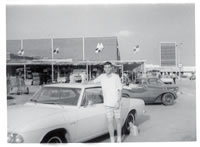 do in an event with lots of entrants. In August 1966, Candace and I drove the hot 90 miles to Houston and entered an autocross put on by the Houston Sports Car association. I was surprised to finish first in class with two other Corvairs rounding out the top three in the GT II class. That’s a picture of me, skinny legs and all, proudly showing my Houston trophy. do in an event with lots of entrants. In August 1966, Candace and I drove the hot 90 miles to Houston and entered an autocross put on by the Houston Sports Car association. I was surprised to finish first in class with two other Corvairs rounding out the top three in the GT II class. That’s a picture of me, skinny legs and all, proudly showing my Houston trophy.
A few of us in the Brazos Sports Car Club went on the road to participate in autocross events within a long day’s drive of College Station. We went frequently to Houston, Dallas, Waco, and Ft. Hood Texas. The big city events were parking lot layouts that were slow and tight. The Waco and Ft. Hood events were very high speed events using normal roads with a few pylon chicanes to keep things somewhat controlled. Jim Ray always won first in class and usually set the TTOD in his Porsche 356 SC. I won first in class consistently. One of my most memorable outings was in December 1966 in the Icicle Grand Prix in Waco, Texas because I got to compete against myself in a hot Mustang.
On December 11, Jim and Wendy Ray, and Candace and I drove to Waco to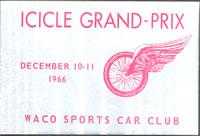 enter the Icicle Grand Prix. The course was laid out in a never-completed subdivision in a gentle hilly area. It was fast. The roads were wide without curbs. It consisted of a loop around a rectangular block with a turn through a cul de sac with a single pylon hairpin and then a quick shot back to the finish line. Two chicanes were placed on the long sides of the rectangle. After I turned in a good time in my first run, a young man approached me with an offer to drive his Mustang in the event. I agreed. enter the Icicle Grand Prix. The course was laid out in a never-completed subdivision in a gentle hilly area. It was fast. The roads were wide without curbs. It consisted of a loop around a rectangular block with a turn through a cul de sac with a single pylon hairpin and then a quick shot back to the finish line. Two chicanes were placed on the long sides of the rectangle. After I turned in a good time in my first run, a young man approached me with an offer to drive his Mustang in the event. I agreed.
Driving the Turbo Corsa in this event was a delight. Driving the souped-up 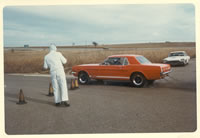 Mustang was a challenge. The Mustang would take off with smoking tires and rear axle dancing. The chassis felt like it was flexing as a part of the suspension. However, in the simple right angle turns it did well and it stormed down the straights. On my last run in the Mustang, I thought that I had beaten my Corvair time by quite a bit due to the dramatic sensations I had experienced. The Corvair seemed boring by comparison. However, that was not the case. I took first in class with the Turbo Corsa and second in class with the Mustang. I have included a few pictures from this event. Mustang was a challenge. The Mustang would take off with smoking tires and rear axle dancing. The chassis felt like it was flexing as a part of the suspension. However, in the simple right angle turns it did well and it stormed down the straights. On my last run in the Mustang, I thought that I had beaten my Corvair time by quite a bit due to the dramatic sensations I had experienced. The Corvair seemed boring by comparison. However, that was not the case. I took first in class with the Turbo Corsa and second in class with the Mustang. I have included a few pictures from this event.
As I thought about the day in Waco, I realized that the 1965 Corvair simply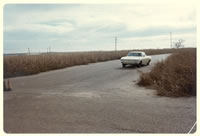 was at ease in the turns, especially the chicane transitions. It was a triumph of sophistication over brute force. My Corsa was not modified. It was completely stock with the standard suspension. The Chevrolet engineers had done a great job when they designed this suspension and it was a winner whether taking a 70 mph slalom, driving on bumpy dirt roads during Texas rallies, or cruising down the highway. I still have the same opinion when I drive my stock 1966 Turbo Corsa in 2005. was at ease in the turns, especially the chicane transitions. It was a triumph of sophistication over brute force. My Corsa was not modified. It was completely stock with the standard suspension. The Chevrolet engineers had done a great job when they designed this suspension and it was a winner whether taking a 70 mph slalom, driving on bumpy dirt roads during Texas rallies, or cruising down the highway. I still have the same opinion when I drive my stock 1966 Turbo Corsa in 2005.
As we went to these different club events, we came to realize what a fabulous resource we had with the use of the Bryan Air Force Base compared to what other clubs had. We decided to put on the event to end all events in the spring of 1967. We choose to call our event a “Time Trial” to differentiate it from the typical autocross. It was going to be fast and long. I soon found myself as the arbitrator of a club disagreement as to what fast meant.
By now, everyone realized that if the course had any significant tight sections, Jim Ray was going to set TTOD in his Porsche. A good Corvette driver, Conrad Dalton, and his brother Warren, who drove very well in a very hot Chevelle SS 396, wanted no tight sections. Jim Ray wanted some tight sections as an equalizer. After much argument, I negotiated the inclusion of one tight slalom section just before the start-finish gate as a safety measure to slow the cars down. This “safety” compromise was successful. Ironically, my brother, Mark, almost flipped his new Ford Cortina GT in this "safety slalom." He drove for a spine-tingling long way on two wheels thinking “dad is going to kill me as I watched in horror thinking the same thing.
We promoted the event on television and in the newspapers in Dallas, Houston, San Antonio, and Waco. We got special trophy donations from the local car dealers. The event was held in May 1967 with a practice on Saturday and the timed runs on Sunday. It was a great success for our small Brazos Sports Car Club.
The course was just over two miles in length. It used two major sections of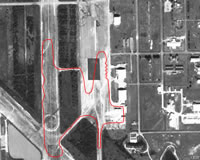 the air field and the connection roads. We borrowed our pylons from the Texas Transportation Institute, which had a facility on the base. Corvair fans should note that the Texas Transportation Institute, Texas A & M Research foundation supported the National Highway Traffic safety Administration’s famous 1972 “Evaluation of the 1960 – 1963 Corvair Handling and Stability” analysis that exonerated the Corvair from Ralph’s Nader’s charges. I like to think of the air base as special ground for Corvair fans. The Texas A & M Sports Car Club has used this same facility for their events from 1968 until today. the air field and the connection roads. We borrowed our pylons from the Texas Transportation Institute, which had a facility on the base. Corvair fans should note that the Texas Transportation Institute, Texas A & M Research foundation supported the National Highway Traffic safety Administration’s famous 1972 “Evaluation of the 1960 – 1963 Corvair Handling and Stability” analysis that exonerated the Corvair from Ralph’s Nader’s charges. I like to think of the air base as special ground for Corvair fans. The Texas A & M Sports Car Club has used this same facility for their events from 1968 until today.
We had a great turnout with over 50 cars that included a number of new 427 Corvettes. In the event, Jim ray took TTOD in his Porsche with Conrad Dalton a close second in his 427 Corvette. I took first in class and 7 th overall. I beat a hot, loud, red 289 Mustang fastback with the 271 HP engine and substantial suspension work to win first in GT II class. The Mustang driver expressed disbelief that he was beaten by a quiet little Corvair. He even alleged that Candace’s working in the timing crew might have been a factor. The high water mark of my short competition career came that Sunday afternoon when I received the “Fastest American Sedan” trophy that was donated by the Ford Dealer.
Just after this event, Candace and I were blessed with our first child in June 1967. We also received orders for an assignment in California following graduate school. In July 1967, we packed most of our belongings in the Corvair with our one month old daughter and headed for California.
We drove at night and slept during the day to avoid the heat. We had a mishap in El Paso Texas where we stopped to visit Candace’s brother who was in the army. We decided to drive to a high viewpoint to see the lights of El Paso. As I started up on the hill with three adults, a baby, our dog, and all our stuff, the yolk holding the inner rear u-joint broke, obviously from the hard life it had led, and the axle knocked off the differential filler plug and ripped out the brake lining. We had a short backward ride before the car stopped. The El Paso Chevrolet dealer told us it would be a week before they could get us a part. We were saved by a local gas station mechanic who built us a new yoke. We were soon on our way again to California.
We drove the 1965 Turbo Corsa as our sole family car until late 1969 when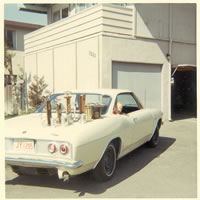 it finally just got very tired after 80,000 hard miles and gave up. One night, after we went shopping about a mile from our apartment, the Corsa just refused to start (it had been getting harder to start for weeks). Candace, who was now eight months pregnant, and I walked home with our groceries and young daughter. I bought a nice 1961 Monza for $200 that we used to bring our new son home from the hospital in November 1969. We towed the Corsa home where it stayed until 1971 it finally just got very tired after 80,000 hard miles and gave up. One night, after we went shopping about a mile from our apartment, the Corsa just refused to start (it had been getting harder to start for weeks). Candace, who was now eight months pregnant, and I walked home with our groceries and young daughter. I bought a nice 1961 Monza for $200 that we used to bring our new son home from the hospital in November 1969. We towed the Corsa home where it stayed until 1971 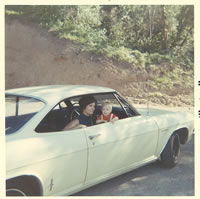 when Candace’s family came to visit with a tow bar. They towed the Corsa back to Tennessee where it was completely restored for use by Candace’s younger brother, Leland, who already owned a red Monza convertible. He used the Corsa for a while and then traded it for a convertible Mustang. He feels bad about this trade to this very day. when Candace’s family came to visit with a tow bar. They towed the Corsa back to Tennessee where it was completely restored for use by Candace’s younger brother, Leland, who already owned a red Monza convertible. He used the Corsa for a while and then traded it for a convertible Mustang. He feels bad about this trade to this very day.
In early 1969, we had thought about buying a new Corvair. This was a sad experience. The local dealers didn't have Corvairs in stock and they simply didn't care. I was upset since the Turbo Corsa was dropped after the 1966 year and now the nice Monza didn't seem enough. Now, in 1970 we started looking at cars again. Candace wanted air conditioning because we planned on return trips through the desert again to visit our families in Illinois and Tennessee. We looked at the Mustangs and Barracudas but weren't thrilled. Then, we saw the new design of the 1970 ½ Camaro and thought that the Rally Sport version was quite beautiful. It reminded me of a Ferrari 250 SWB.
Candace ran a day care baby sitting service and I took a part time 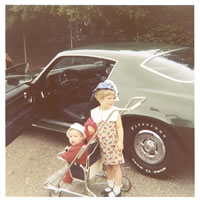 programming job so that we could save the down payment for a new Camaro. In spring of 1970, we took delivery of a beautiful SS 350 Camaro, with the Rally Sport front end, front disk brakes, automatic, air conditioning, and positraction. We gave away our 1961 Monza to a friend in Felton where it quietly went to rust among the redwoods. Our early association with Corvairs ended just as Chevrolet ended the Corvair itself. My interest in Corvairs didn't die; it just submerged to surface some thirty-plus years later. programming job so that we could save the down payment for a new Camaro. In spring of 1970, we took delivery of a beautiful SS 350 Camaro, with the Rally Sport front end, front disk brakes, automatic, air conditioning, and positraction. We gave away our 1961 Monza to a friend in Felton where it quietly went to rust among the redwoods. Our early association with Corvairs ended just as Chevrolet ended the Corvair itself. My interest in Corvairs didn't die; it just submerged to surface some thirty-plus years later.
My experience with Corvairs ran from 1961 until 1970. I was fortunate to 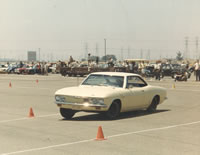 drive three very special examples of the Corvair line. I first went beyond the limits in my 1961 Monza. I was thrilled as I thrashed a 1962 Spyder learning car control on asphalt and ice. Finally, I drove a 1965 Turbo Corsa around town, as a daily work car, as a family car on many long trips, and successfully as a true “poor man’s Porsche” in competitions in Texas. The Corvairs ran great in heat and cold, they never turned over, they didn't leak oil, and I only threw one fan belt. Last but not least, I met the love of my life when a 16 year old neighbor girl asked me if my 1961 Monza had a stick shift. drive three very special examples of the Corvair line. I first went beyond the limits in my 1961 Monza. I was thrilled as I thrashed a 1962 Spyder learning car control on asphalt and ice. Finally, I drove a 1965 Turbo Corsa around town, as a daily work car, as a family car on many long trips, and successfully as a true “poor man’s Porsche” in competitions in Texas. The Corvairs ran great in heat and cold, they never turned over, they didn't leak oil, and I only threw one fan belt. Last but not least, I met the love of my life when a 16 year old neighbor girl asked me if my 1961 Monza had a stick shift. |



